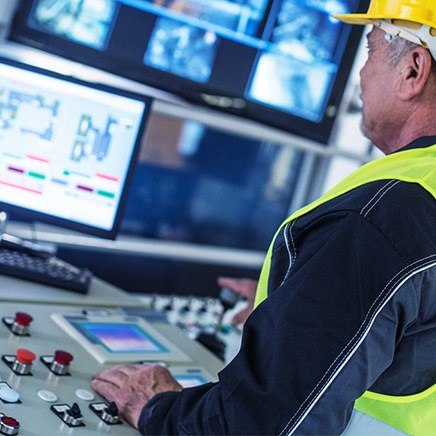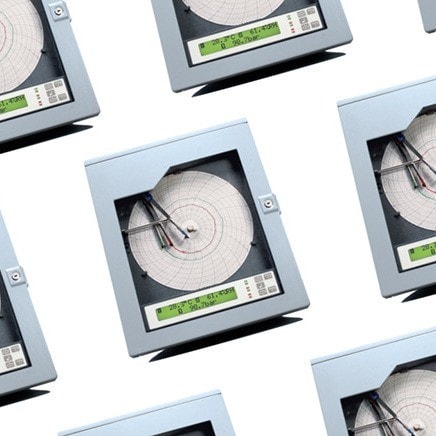In transporting perishable product, it’s becoming ever more important to provide records of the temperatures, and in some cases, humidity, to which cargo has been exposed. This White Paper provides some background to temperature and humidity logging in logistics and discusses equipment options. After finishing this paper the reader should have an appreciation of the reasons for capturing temperature and humidity data and an understanding of the equipment available and how it can be used.
Background to Temperature Monitoring
Many products deteriorate quickly at room temperature, and faster still as temperatures rise higher. Food items such as fruit, meat and fish cannot be shipped long distances without refrigeration. In some instances chilling to 13°C (55°F) is sufficient for produce to be sold fresh (or that does not freeze readily) such as bananas. Eggs are another example, where humidity control is also required. Other products need to be frozen to prevent deterioration. The same is true for many pharmaceutical and medical products. The Healthcare Distribution Management Association estimates that some 10% of drugs are temperature sensitive. Vaccines and blood products are other examples of medical products needing strict temperature control, although these are sometimes subjected to freeze-drying through the lyophilization process.
The need for temperature control extends beyond products for human consumption. Some specialist paints or coating materials will be damaged by exposure to low temperatures. Other chemicals must be kept within strict temperature limits during transportation.
Another area is the shipping of antiquities and works of art. For these humidity can be a bigger concern than temperature as it can lead to mold, especially if the two are combined.
The Cold Chain
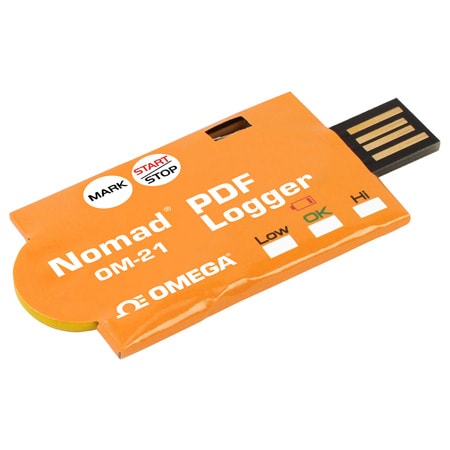 OM-21 Data Logger
OM-21 Data Logger
Perishable products must be kept at a controlled temperature, from point of origin to delivery to retailer or pharmacy. The logistics industry refers to this as the “cold chain” and it encompasses both “reefers” (refrigerated containers) as well as warehouses, distribution centers and the final storage or holding areas.
Throughout this chain the risk of failure is ever-present, meaning there is always a possibility of cargo exceeding permissible or safe temperature levels, even if only briefly. For example, a truck might be stopped without power in desert heat, allowing temperatures in the reefer to rise. Then power is restored and the temperature in the container comes back down, but the product is damaged.
Cost and Liability Issues
When cargo such as any of those items listed above are exposed to temperatures outside of prescribed limits it can be damaged. In some cases this is evident, such as with bananas, but in other situations, like the transport of vaccines, it may not be apparent that damage has occurred and the vaccine becomes ineffective. For some products, going over temperature, even only briefly, can reduce shelf life dramatically, incurring substantial costs when it cannot be sold.
Organizations contracting to ship perishable products often specify the permissible temperature range. However, even if it is possible to show that product was exposed to conditions outside of those contracted, proving where it happened, and thus responsibility, can be much harder. The answer is to create a time-based record of the temperatures experienced.
Recording Temperature and Humidity
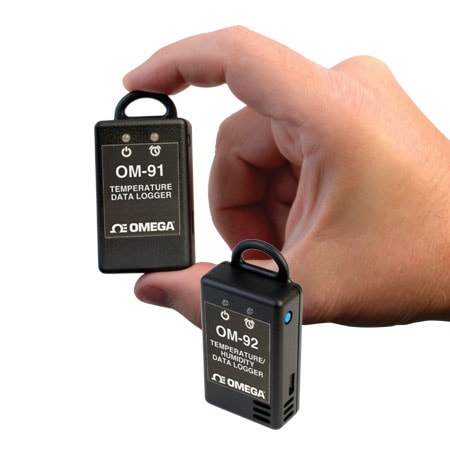 OM-90 Series Data Logger
OM-90 Series Data Logger
The maximum-minimum thermometer was invented around 1780, and for a long time was the only means of recording the highest and lowest temperatures observed over a given period. Besides employing mercury as the expansion medium, its other weakness was the absence of any time record. As a result, while such a thermometer could be included in a shipment of fruit there would be no way to know when or for how long the peak temperature was experienced. Without this information it’s difficult to determine responsibility for any spoilage.
The same applies to humidity indicators. Various types are available, most of which utilize some color-change effect to show either the peak humidity experienced or the current humidity. As with the max-min thermometer though, there is no time record to support claims for negligence.
Portable Electronic Temperature and Humidity Data Loggers
Advances in digital electronics led to the portable data recorder. Battery powered, these are small enough to be placed next to or among perishable cargo where they log the temperature or humidity. They can be set to create a record as frequently as every second or as infrequently as hourly. Some even allow an 18 hour interval. The only limitation is the number of data points that can be stored, so if set to record at a high rate they will run out of space sooner.
Temperature accuracy is typically ±0.5°C and humidity ±3.0% RH. They can be programmed to start after a delay period. Once recovered they can be plugged in to a PC and the data transferred into Excel® or any other package for analysis. Alarms can be set to illuminate LED indicators if maximum or minimum limits have been exceeded, making any potential problem immediately visible.
EudraLex/FDA Compliant Temperature Loggers
 OM-CP-LYOTEMP Data Logger
OM-CP-LYOTEMP Data Logger
Under CFR 21 the FDA requires that drugs be stored at appropriate temperatures. Loggers can be used to demonstrate compliance with this standard, and electronic records are admissible under 21 CFR Pt.11. (Within the EU, EudraLex Volume 4, Annex 11). The FDA also expects that temperature monitoring will be carried out during the lyophilization process when applied to materials of a biological origin.
Loggers Carried by OMEGA
OMEGA offers a range of temperature and humidity loggers for various applications. The compact OM-90 series cover a range from minus 30 to 80°C (-22 to 176°F) and humidity from 0 to 100% RH and can log some 65,000 measurements.
Intended specifically for monitoring the transport of eggs, the OM-CP-EGGTEMP series are egg-shaped for easy inclusion in shipping packages and operate over a temperature range of 0 to 60ºC (32 to 140°F) and 0 to 95% RH. Over 32,000 readings can be held in memory.
The lyophilization process demands very low temperatures, so the OM-CP-LYOTEMP was designed with an operating range of minus 60 to 75°C (-76 to 167°F). This logger connects to a PC via USB docking station and the purpose-written software includes features such as mean kinetic temperature recording.
For situations demanding multiple data sets, such as when several freezers are used for storage, OMEGA offers the four channel OM-DVT4. Accepting inputs from three external probes plus the internal sensor, this has an LCD display showing all four temperatures along with alarm status, memory remaining, sample status, and other settings.
An alternative approach for cold chain temperature monitoring is the single use temperature recorder. OMEGA offers both the OM-CP-TRANSITEMP-EC and the OM-21 data loggers. Compact and inexpensive, these are intended to be loaded in with the cargo at the point of origin and retrieved on final delivery. Their operating range is minus 20 to 70°C (-4 to 158°F) [minus 30ºC (-22ºF) for the OM-21] and as with the other loggers described, the data gathered may be easily transferred to a PC for review. (The OM-21 actually prepares the data in pdf format and behaves like a USB flash drive).
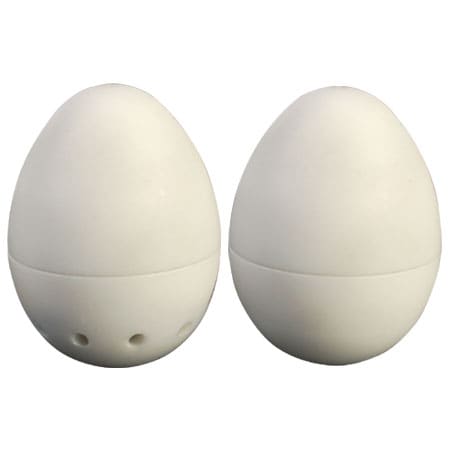 OM-CP-EGGTEMP Data Logger
OM-CP-EGGTEMP Data Logger
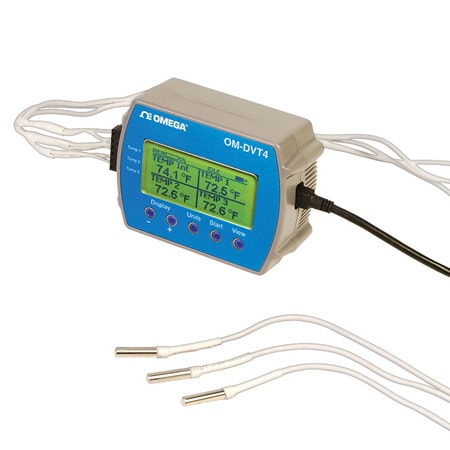 OM-DVT4 Data Logger
OM-DVT4 Data Logger
 OM-CP-TRANSITEMP-EC Data Logger
OM-CP-TRANSITEMP-EC Data Logger
Takeaways
A wide range of products, from vaccines and chemicals to eggs and works of art, must be shipped under controlled environmental conditions. Portable temperature and humidity loggers provide a time-stamped record of the conditions encountered in transit and are an invaluable source of evidence should claims be made for loss or damage.
In the pharmaceutical field FDA regulations insist that drugs be stored at correct temperatures and that lyophilization be performed under controlled conditions. Logging of temperature and humidity provides evidence of compliance, and if performed correctly, will meet FDA requirements for electronic record-keeping.
The latest generation of temperature and humidity loggers are compact and inexpensive, making them easy to include with shipping or transport packages. Accuracies are typically within 0.5°C and batteries are long-lasting. Such technology is enabling dramatic growth in temperature logging, helping ensure the safety of supply chains and products intended to maintain human health.
